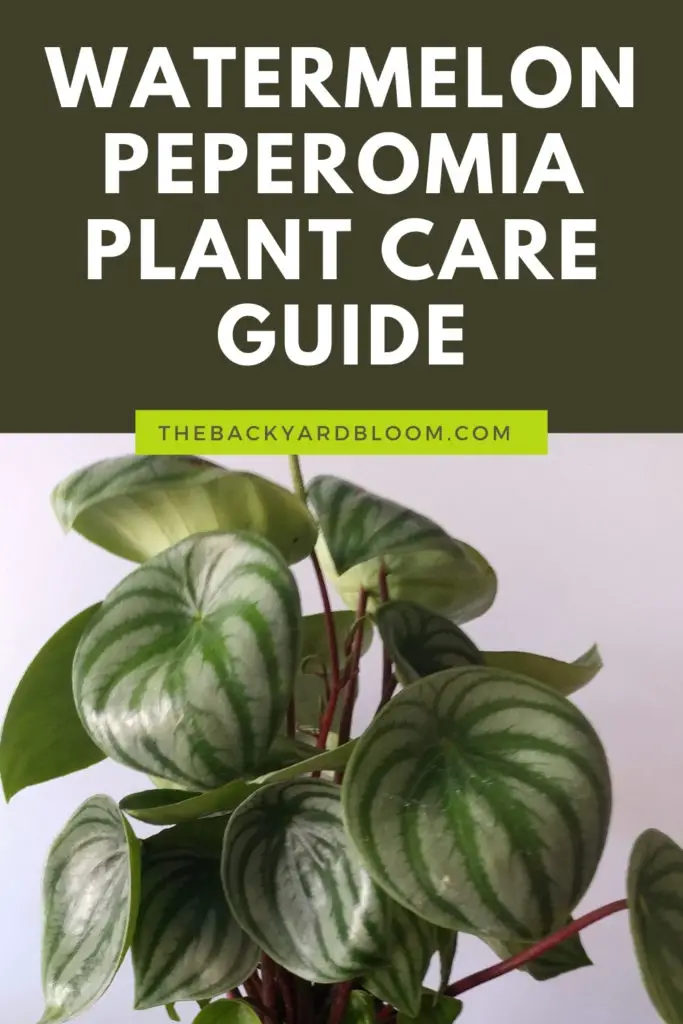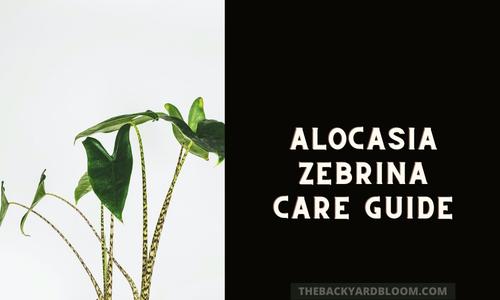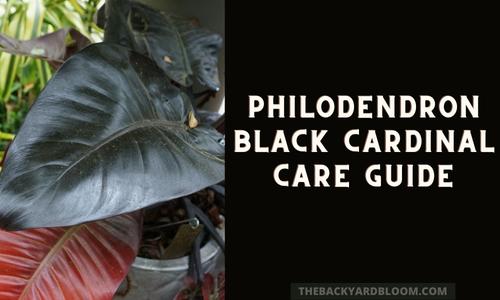Please note that this post may contain affiliate links. You can read my full affiliate disclosure at the bottom of the page.
Watermelon Peperomias are an easy-to-grow variegated house plant with leaves that resemble watermelons. Over the last year, they have become a very popular house plant. And with this rise in popularity, many people are wondering how to care for their new Watermelon Peperomia.
They are a very unique-looking plant, that is native to South America, with leaves that look like a watermelon. This is why they are called Watermelon Peperomia. The other name that they are known by is Peperomia Argyreia.
- Origins
- How To Water a Watermelon Peperomia Plant
- Light Requirements
- What Soil to Use with Watermelon Peperomias
- How To Repot Watermelon Peperomia Plants
- Propagation
- Watermelon Peperomia Toxicity
- Fertilizing
- Maintenance
- Common Problems With Watermelon Peperomia Plants
- Frequently Asked Questions About Watermelon Peperomia Plants?
Origins
Watermelon Peperomias are native to the South American tropical forests. They can be found there growing on materials on the forest floor such as wood that has fallen from trees and is rotting.
They grow in tropical forests in the understory so they are not used to having direct sunlight, they are used to being provided a good amount of shade.
Over the last couple of years, they have gained in popularity as house plants.
Their variegated leaves resemble watermelons, giving them the name Watermelon Peperomia.
They can grow up to 12 inches tall, but usually are around 8 inches tall, and tend to be a bushy plant when given the right growing conditions. They can reach their full size within a few years.
How To Water a Watermelon Peperomia Plant
When watering Watermelon Peperomias it is best to treat them like you would a succulent. They can be very prone to overwatering and rot.
Never leave your plant sitting in soggy soil or sitting in water too long.
And always make sure to let your plant’s soil dry out between watering. If the soil is left dry for too long this can result in your Watermelon Peperomia getting droopy leaves.
During the summer months, you will need to water your plant more often and cut back on watering during the winter months.
Squeeze Method To Check Water Needs
A way that you can see if this plant needs water is to squeeze the leaves gently. If there is a lot of give in the leaf when you squeeze it and it folds without any resistance, then it is in need of water. But if they have some resistance and feel firm they have enough water in the leaves to supply the plant with what it needs.
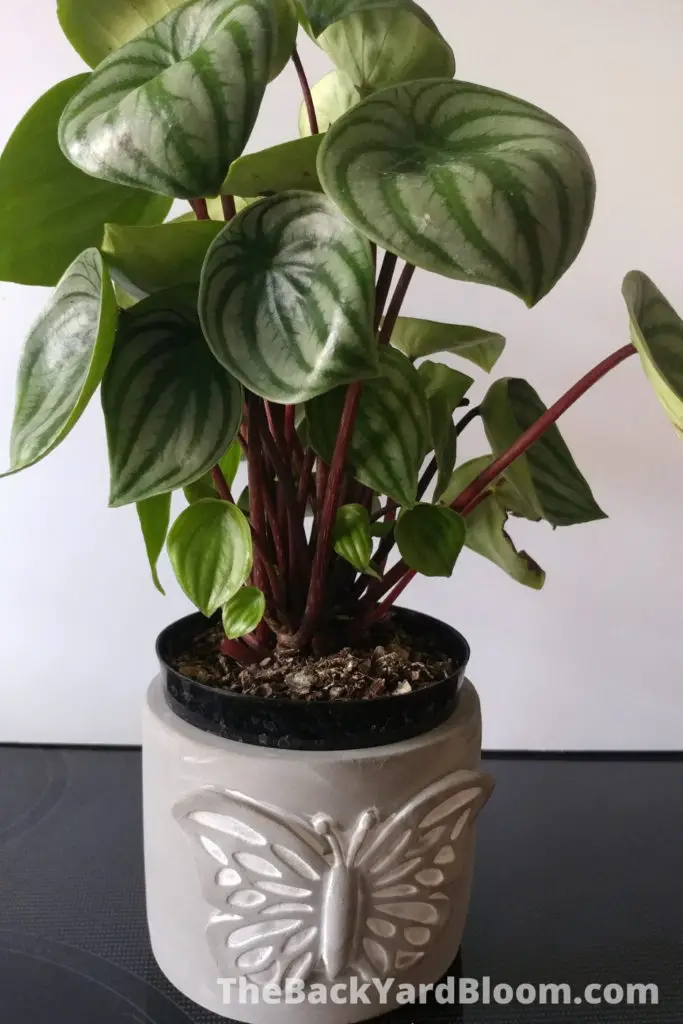
A way to help make sure you don’t overwater this plant is to leave it in a nursery pot and place it in the decorative pot like I have done in the picture above. This way when my plant needs water I just place the plant and its nursery pot in a container that has water and let it soak up what it needs. By doing this I am sure that my plant will not be sitting in water and getting rot.
Another way that people help avoid rot due to too much water with these plants is to plant them in a terracotta pot. This type of pot helps take away moisture from the roots and helps avoid root rot.
Soil moisture sensor is another tool you can use so you can be sure of the soil moisture levels.
Light Requirements
Watermelon Peperomias do not like direct sunlight. Even very bright indirect light can cause issues with them some people find.
Too much light can cause the leaves to curl. Sometimes the plant will lose color in the leaves too from too much light.
Since they are native to the understory of tropical rainforests, they are not a plant that is used to an abundance of bright direct light.
Rooms with large windows are a great area to keep this plant.
But they can tolerate medium levels of light.
These are a great house plant when you have north-facing windows.
I currently have mine about 4 feet away from an east-facing sliding glass door where it gets a good amount of indirect light throughout the day and it is doing great. I’ve had others in rooms with western-facing windows where more light comes in during the last half of the day and started to get leaf curling so I try to keep mine in a room with either a north-facing or eastern-facing window.
Just be sure not to let the leaves touch the window during the cold months as they do not tolerate cold temperatures well.
What Soil to Use with Watermelon Peperomias
A well draining soil is best to use for these plants. Peat based is what is recommended with perlite mixed in to aid with water drainage.
You do not want a soil that will retain water easily and allow the plant to sit while it is soggy.
If you want to use premixed soil, make sure that it is one that is well draining such as succulent soil mix.
If you want to make your own soil you can use 1 part peat moss, 1 part compost, and 1 part perlite. (What is Perlite Used For?)
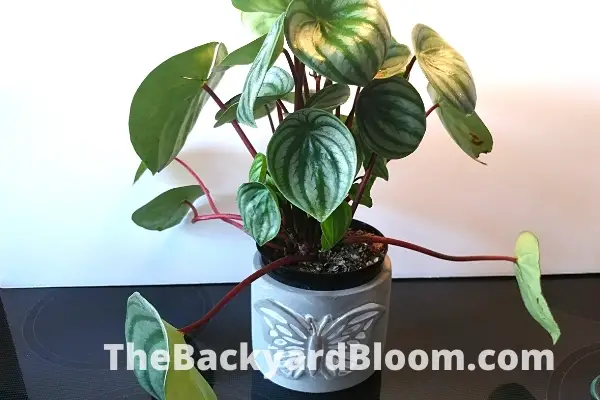
How To Repot Watermelon Peperomia Plants
When you repot these plants, make sure you select a pot that allows for drainage.
If not keeping your plant in the nursery pot to allow easy drainage then terracotta plant pots are the best choice. This way the pot itself helps wick some of the moisture out and away from the roots of the plant. This can help avoid the plant from getting root rot.
Watermelon Peperomias do like to be somewhat root bound, so repotting them only needs to be done once every year or two.
When repotting it is best to choose a pot that is only a bit bigger than the previous pot it was in. If you are repotting this right after you bought it, do not use a pot that is much bigger than the one it is already in. And it might be best since it has just been purchased to select one that is the same size as the pot it is in currently.
Propagation
There are several ways to propagate Watermelon Peperomia.
The most popular way to propagate these plants is to use leaf cuttings. Growing pups this way gives you better and stronger roots.
Take a good-sized leaf and cut it in half. You can also use damaged leaves (like if your cat decided it was a fun chew toy). Then plant the halves with the cut side down, make a dome cover for the container they are in to help keep them humid. You will want to sit the container that these are planted in and place it in a bright area then wait several months for pups to appear.
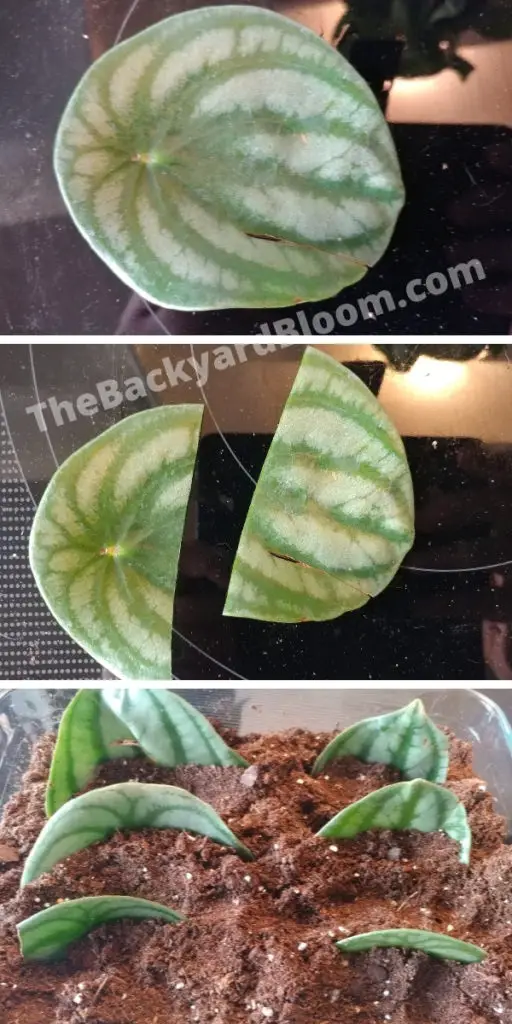
Another way is placing cuttings in water. Place the stem in water and wait for roots to grow. This method can take 6 weeks or more. And it is said to work better with several cuttings in the same container instead of just one at a time.
Watermelon Peperomia Toxicity
Watermelon Peperomias are not toxic to cats or dogs. They are a safe house plant to have around pets (1).
However if your cats tend to chew on plants, this can damage the leaves. I use Bitter Apple for plants to help keep them safe from cat teeth.
Fertilizing
Watermelon Peperomias are light feeders and do not require much for feeding.
If they get too much fertilizer it can cause them to grow leggy and instead of a nice compact bushy plant.
When fertilizing them it is best to use a water-soluble liquid fertilizer. Only use about half of what the fertilizer recommends. During the spring and summer fertilize them each month and during the fall and winter only fertilize them every two to three months.
Maintenance
Make sure to cut or pinch off any dead leaves. If you like to have a bushier plant then cut off any flowers that pop up. However, if you would like to keep the flowers then cut them back after they have stopped blooming.
Common Problems With Watermelon Peperomia Plants
Root Rot
Watermelon Peperomias are prone to root rot. To avoid this make sure to not overwater the plant or leave it sitting in soggy soil.
Use well-draining soil and use a pot that will help keep the soil drained. Always make sure your pot has a drainage hole.
Curling Leaves
Curling leaves can mean that the plant is in too bright of light. This can easily happen if you keep your Watermelon Peperomia outside in a brightly lit area even though there is no direct sunlight.
Dropping Leaves
The most common reason for a Watermelon Peperomia dropping its leaves is due to overwatering. Cut back on watering and remember to make sure to let the soil dry out between waterings.
The second most common reason for this plant dropping leaves is due to temperatures being too cold. If your plant is in a drafty area, find a new location away from air drafts to keep it. If it is in a room that goes below 60°F then move it to a location that will stay above that level.
Another possible reason for dropping leaves is the shock of watering your plant with cold water. Always make sure to use room temperature water when watering any plants.
Yellowing Leaves
This is another sign that your plant is getting too much water or that the soil is not draining properly.
Check to make sure your pot is allowing drainage to occur and make sure that the soil is dry when you are watering your plant.
Black Spots on the Leaves
Black spots on the back of the leaves of a Watermelon Peperomia usually mean that it is getting direct sunlight. Find another location that won’t allow the plant to be in direct sunlight.
Brown Spots on the Leaves
Brown spots on the leaves of a Watermelon peperomia can be caused by one or more issues:
- Environmental Stress
- Pests
- Disease
- Incorrect Lighting
- Nutrient Deficiencies
- Overwatering
- Underwatering
If you are finding brown spots on the leaves of your plant it is best to try to assess your plant’s individual situation.
If you just got the plant then environmental stress is the most likely factor causing brown spots.
Pests could also be an issue when you first purchase the plant. Many people find it best to isolate a new houseplant to make sure they don’t bring new pests to their current plants. If you suspect that pests could be causing the brown spots, use insecticidal soap or Neem oil to treat the plant.
If the light levels are low and you notice that the plant grows leggy in addition to the brown spots then this could be an issue of not having enough light.
On the other hand, if you have your plant in a location where it is sitting in direct sunlight then the brown spots are most likely due to too much sunlight.
Pay attention to the soil of your plant, if you are finding that it is completely dry and your plant is constantly drooping then the brown spots could be due to underwatering. If the soil is always moist and all other factors don’t seem to be contributing factors to brown spots then they could be due to overwatering the plant.
Nutrient deficiencies are still a possibility even though Watermelon Peperomias are not a plant that needs much fertilizer. Although this is one of the reasons that are less likely for brown spots. You can always get a soil test to see if the soil you are using for your plant is lacking in anything essential that the plant needs.
Disease in a plant is often a result of one of the above issues. In order to have a healthy plant that is resistant to disease you must provide it with the right light, the right amount of water, not let it get overrun with pests, and make sure it has the nutrients that it needs to thrive.
Pests
Watermelon Peperomias don’t have serious pest problems.
If the plant becomes weak this can make it susceptible to insects like spider mites or mealybugs.
But making sure that the plant gets the right amount of light and water is usually enough to keep it healthy so you won’t have as many pest problems.
Frequently Asked Questions About Watermelon Peperomia Plants?
Watermelon Peperomias do not handle cold temperatures well. They are only winter hardy in Zones 10-12. (2) If you do decide to put it outside then it is best to only keep it outside only during the warmer months when the temperature is stable and doesn’t have big fluctuations. Make sure the plant is in a shaded area. They grow best in temperatures of 60°F to 85°F and they do not like sharp temperature drops.
The most common reason for leggy Watermelon Peperomias is due to lack of light. While they don’t like very bright light or direct sunlight, too little light can cause the plant to grow leggy as it tries to reach more light.
The second most common reason for this plant growing leggy is due to too much fertilizer. They are not heavy feeders and should only receive half of the recommended amount on your plant food.
Watermelon Peperomias can flower. Their flowers appear on spikes that rise above the plant’s foliage. Usually, most growers trim these off since they can take away energy from the plant for growing more leaves.
If your humidity levels are not above 50% it is ok to mist your plant every couple of days with water.
With the proper care, these beautiful plants can live for five or more years.
Brown spots on a Watermelon Peperomia can be due to several issues. Environmental stress, pest infestation, disease, incorrect lighting, nutrient deficiencies, and overwatering or underwatering can all cause brown spots to appear on the plant. See our section on brown spots to see how to determine what might be causing the brown spots on your plant.
References
- https://www.aspca.org/pet-care/animal-poison-control/toxic-and-non-toxic-plants/watermelon-peperomia
- https://www.missouribotanicalgarden.org/PlantFinder/PlantFinderDetails.aspx?kempercode=b608
